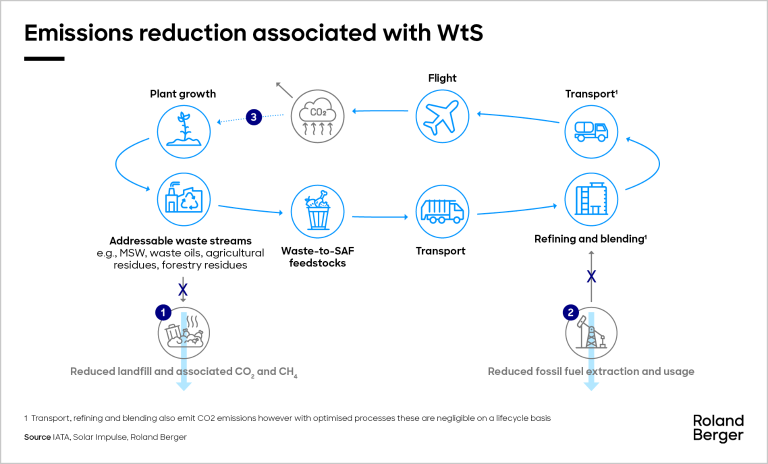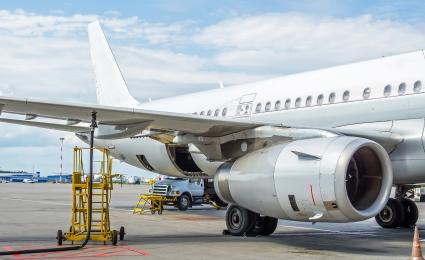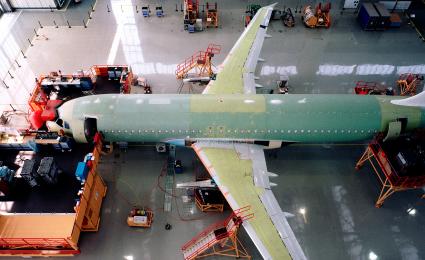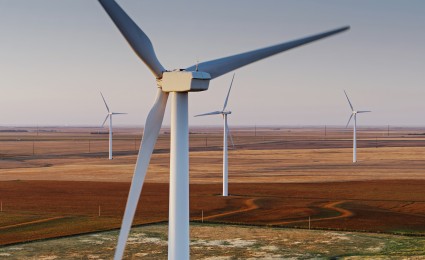Aviation’s Roadmap to True Zero: Why measuring non-CO2 emissions matters – and how we can do it.


Circular SAF: Waste-to-SAF as a critical bridge to a sustainable future for aviation
How circularity can help to pave the way to net zero in the aviation industry
Waste – be it food waste, waste oils, agricultural residues, or even waste carbon dioxide – is an important feedstock in the production of sustainable fuels. The aviation industry, which will require millions of tonnes of sustainable aviation fuel (SAF), considers the conversion of waste-to-SAF (WtS) as a key decarbonization lever. But is WtS a viable long-term option practically and economically, and how should players approach this emerging market? Our new report aims to answer these questions and more.

"Waste-to-SAF can be the bridge that SAF requires, from today’s expensive and feedstock limited options to tomorrow’s PtL."
The aviation industry, which is responsible for around 3% of all industrial CO2 emissions, is betting big on sustainable aviation fuels (SAF). It hopes that SAF can pave the way to net zero by reducing emissions by between 20% and 70% by 2050. The problem is that currently there is not enough SAF supply to meet expected demand, with many major airlines making significant SAF targets by 2030.
The production of SAF from waste, or waste-to-SAF (WtS), offers a possible solution. It involves making fuels from various circular waste feedstocks, such as waste oils, municipal solid waste and agricultural/forestry residues. While CO2 is still produced in its usage, the lifecycle carbon intensity reduction of WtS can be as high as 90-95%.This is due to 3 emissions reductions enabled by the circular production process of WtS: (1) it reduces disposal methods that produce emissions (such as landfill), (2) it avoids emissions from conventional jet fuel and, (3) due to some of the feedstock being plant-based, it partly helps to remove atmospheric CO2.
In our new report, “Circular SAF: Waste-to-SAF as a critical bridge to a sustainable future for aviation”, we assess the role that WtS might play in the net-zero transition of aviation. It provides an in-depth look at the current state of global SAF production, SAF and WtS production pathways, the relative sustainability of different types of SAF, the supply potential of WtS and the economic case for WtS. The report also seeks to answer vital questions for SAF stakeholders, such as: how should airlines integrate WtS within their overall SAF portfolio? How should potential producers and investors think about the WtS opportunity? How should waste managers assess WtS as an option for waste disposal? And how can governments build an ecosystem that stimulates SAF and WtS uptake?
A critical bridge to sustainability
One of the main benefits of WtS production is the variety of feedstocks and pathways can that be used to produce WtS. This includes the HEFA process, today the most widely used, whose feedstocks already include waste oils. This also includes agricultural residues, forestry residues, (some of) municipal solid waste, and other waste feedstocks, being processed either via the AtJ, Fischer-Tropsch (FT) or soon the MtJ process to make SAF.
Ultimately, the long-term “most sustainable” solution (as demonstrated by the Roland Berger SAF Sustainability Index) is power-to-liquid (PtL) technology. This involves combining green hydrogen with sustainably captured CO2 to produce a gas which can be readily converted to SAF. Today in most regions PtL remains costly, albeit the Inflation Reduction Act (IRA) is contributing to an improvement in the cost competitiveness of PtL in the US. However, the critical benefit of PtL is that it is largely feedstock unconstrained (only constrained by the availability of green energy), and is thus likely to form the backbone of most future production as industrialization occurs and costs come down. A key focus of our report was therefore to examine if WtS could act as a bridging technology on the journey to future SAF production pathways such as PtL.
The report finds that WtS has a strong business case today, with commercially available technologies, a strong emissions reduction profile versus alternative SAF production pathways, and a compelling economic logic that benefits from rapid expected SAF market growth, subsidies and waste gate/tipping fees. The supply potential of WtS is also significant, supporting a 'portfolio' approach to scaling up SAF production that manages the risks and limitations of each pathway.
This creates a viable way for the industry to transition away from today’s dominant HEFA pathway, which has several shortcomings – high cost, relatively poor carbon mitigation efficacy, a potential negative impact on food systems, and feedstock limitations. Thus, as the industry industrializes towards PtL, we conclude that WtS can act as an effective bridging solution, with a highly effective emissions reduction profile and scalable feedstocks compatible with multiple SAF pathways.
To support the use of WtS in the industry, the report offers several recommendations to stakeholders:
- SAF producers should evaluate the business case to enter or expand their position in WtS, while refineries should think through how they can leverage their existing infrastructure to capitalize on WtS
- Waste managers should critically consider the relative environmental impact and economics of alternative economic pathways, for example comparing WtS and waste-to-energy
- Airlines should carefully consider the composition of their SAF portfolios, with differing considerations for the short-, medium- and long-term
- Investors should consider WtS production as a Core++ / Value Add investment, while aircraft lessors should consider whether investing in SAF can help protect the long-term residual values of their aircraft portfolio
- Last but not least, governments should consider how an ecosystem can be created to stimulate SAF uptake to accelerate the decarbonization of aviation
For more information, please download the full report or contact one of our experts.
We would like to thank Nathaniel Trueman for his contribution to this study.
Register now to access the full study, that explores how circularity can help to pave the way to net zero in the aviation industry. Furthermore, you get regular news and updates directly in your inbox.

_person_144.png)






